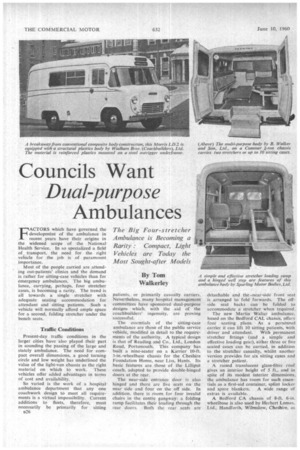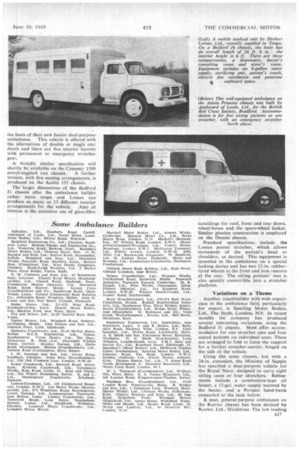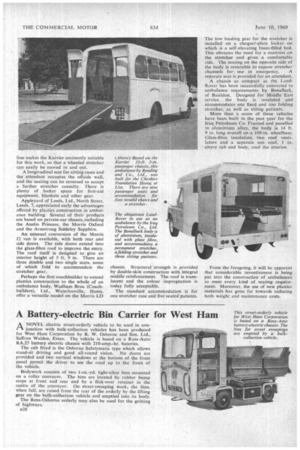Councils Want Dual-purpose Ambulances
Page 92

Page 93

Page 94

If you've noticed an error in this article please click here to report it so we can fix it.
By Torn Walkerley FACTORS which have governed the development of the ambulance in recent years have their origins in the widened scope of the National Health Service. In so specialized a field of transport, the need for the right vehicle for the job is of paramount importance.
Most of the people carried are attending out-patients clinics and the demand is rather for sitting-case vehicles than for emergency ambulances. The big ambulance, carrying, perhaps, four stretcher cases, is becoming a rarity. The trend is all towards a single stretcher with adequate seating accommodation for attendant and sitting patients. Such a vehicle will normally afford ample space for a second, folding stretcher under the bench seats.
Traffic Conditions
Present-day traffic conditions in the larger cities have also played their part in sounding the passing of the large and stately ambulance. The need for compact overall dimensions, a good turning circle and low weight has underlined the value of the light-van chassis as the right material on which to work. These vehicles offer added advantages in terms of cost and availability.
So varied is the work of a hospital ambulance department that any one coachwork design to meet all requirements is a virtual impossibility. Current additions to fleets, therefore, must necessarily be primarily for sitting 1326 patients, or primarily, casualty carriers. Nevertheless, many hospital management committees have sponsored dual-purpose designs which, with the aid of the coachbuilders' ingenuity, are proving successful.
The essentials of the Sitting-case ambulance are those of the public service vehicle, modified in detail to the requirements of the authority. A typical design is that of Reading and Co.. Ltd., London Road, Portsmouth. This company has built a nine-seater on a Karrier IO-ft. 3-in.-wheelbase chasSis for the Cheshire Foundation Home, near Liss, Hants. Its basic features are those of the Lilliput coach, adapted to provide double-hinged doors at the rear.
The near-side entrance door is also hinged and there are five seats on the near side and four on the off side. In addition, there is room for four invalid chairs in the centre gangway: a folding ramp facilitates their loading through the rear doors, • Both the rear seats are detachable and the. near-side front seat is arranged to fold ,forwards. The offside seat backs can be folded to accommodate a stretcher when required.
The new Martin Walter ambulance, based on the Bedford CAL chassis, offers
• four seating plans. As a personnel carrier it can lift 10 sitting patients, with driver and attendant. With 'permanent stretcher fitting's (and a simple and effective loading gear), either three or five Seated cases can be carried, in addition to the stretcher casualty, whilst another version provides for six sitting cases and a stretcher patient.
A raised translucent glass-fibre roof gives an interior height of 5 ft., and in spite of its modest interior dimensions, the ambulance has room for such essentials as a first-aid container, splint locker and spare blankets. A wide range of extras is available.
A Bedford CA chassis of 8-ft. 6-in. wheelbase is also used by Herbert Lomas, Ltd., Handforth, Wilmslow, Cheshire, as
the basis of their new Junior dual-purpose ambulance. This vehicle is offered with the alternatives of .double or single rear doors and there are five interior layouts with permanent or emergency stretcher gear.
A broadly similar specification will shortly be available on the Commer 1500 petrol-engined van chassis. A further version, with five seating arrangements. is produced on the Austin 152 chassis.
The larger dimensions of the Bedford .11 chassis offer the ambulance builder rather more scope and Lomas can produce as many as 13 different interior arrangements for the vehicle. Also of interest is the extensive use of glass-fibre mouldings for roof, front and rear doors, wheel-boxes and, the spare-wheel locker. Similar plastics construction is emplbyed on the Dennis chassis.
. Standard specifications, include the Lomas patent stretcher, which allows 'movement of the patient's head or shoulders, as desired. This equipment is mounted in the ambulance on a special locking device and has two I2-in. rubbertyred wheels at the front and iron runners at the rear. The sitting patients' seat is alSo quickly convertible into a stretcher platform.
Variations on a Theme
Another coachbuildcr with wide experi ence in the ambulance field, particularly for export, is Spurling Motor Bodies, Ltd., The Hyde, London, N.9. In recent months the company has produced several interesting variations, using the Bedford J1 chassis. Most offer accommodation for one stretcher case and four seated patients on individual seats. These are arranged to fold to form the support for a further stretcher-carrier, hinged on the side of the vehicle.
Using the same chassis, but with a 24-in. extension. the Ministry of Supply has specified a dual-purpose vehicle for the Royal Navy, designed to carry eight sitting cases or four stretchers. Refine ments include a combustion-type oil heater. a 12-gal, water supply warmed by the heater, and a Perspex hand-basin connected to the tank below.
A neat, general-purpose ambulance on the Karrier chassis has been devised by Rootes, Ltd., Maidstone. The low loading 1327 line makes the Karrier eminently suitable for this work, so that a wheeled stretcher can easily be moved in and out.
A longitudinal seat for sitting cases and the attendant occupies the offside wall, and the seating can be reversed to accept a further stretcher casualty. There is plenty of locker space for first-aid equipment, blankets and other gear.
Appleyard of Leeds, Ltd., North Street, Leeds, 7, appreciated early the advantages offered by plastics construction in ambulance building. Several of their products are based on private-car chassis, including the Austin Princess, the Morris Oxford and the Armstrong Siddeley Sapphire.
An unusual conversion of the Morris .12 van is available, with both rear and side doors. The side doors extend into the glass-fibre roof to improve the entry. The roof itself is designed to give an interior height of 5 ft. 9 in. There are three double and two single seats, some of which fold to accommodate the stretcher gear.
Perhaps the first coachbuilder to extend plastics construction to the whole of an ambulance body, Wadham Bros. (Coachbuilders), Ltd., Waterlooville, Hants, offer a versatile model on the Morris LD chassis. Structural strength is provided by double-skin construction with integral middle reinforcement. The roof is translucent and the colour impregnation is today fully acceptable.
The standard accommodation is for one stretcher case and five seated patients. The low loading gear for the stretcher is installed on a chequer-plate locker on which is a self-elevating foam-tilled bed. This obviates the need for a mattress on the stretch& and gives a comfortable ride. The seating on the opposite side of the body is reversible to expose stretcher
channels for use in emergency. A separate seat is provided for an attendant.
A chassis as compact as the LandRover has been successfully converted to ambulance requirements by Bonallack, of Basildon. Designed for Middle East service, the body is insulated and accommodates one fixed and one folding stretcher, as well as sitting patients.
More than a score of these vehicles have been built in the past year for the Iraq Petroleum Co. Framed and panelled in aluminium alloy, the body is 14 ft. 9 in. long overall on a 109-in. wheelbase. Glass-fibre insulation, two roof ventilators and a separate sun roof, 1 in. above cab and body, .cool the interior.
From the foregoing, it will be apparent that considerable inventiveness is being put into the construction of ambulances to meet every kind of seating requirement. Moreover, the use of new plastics materials has gone far towards reducing both weight and maintenance costs.




















































































































































